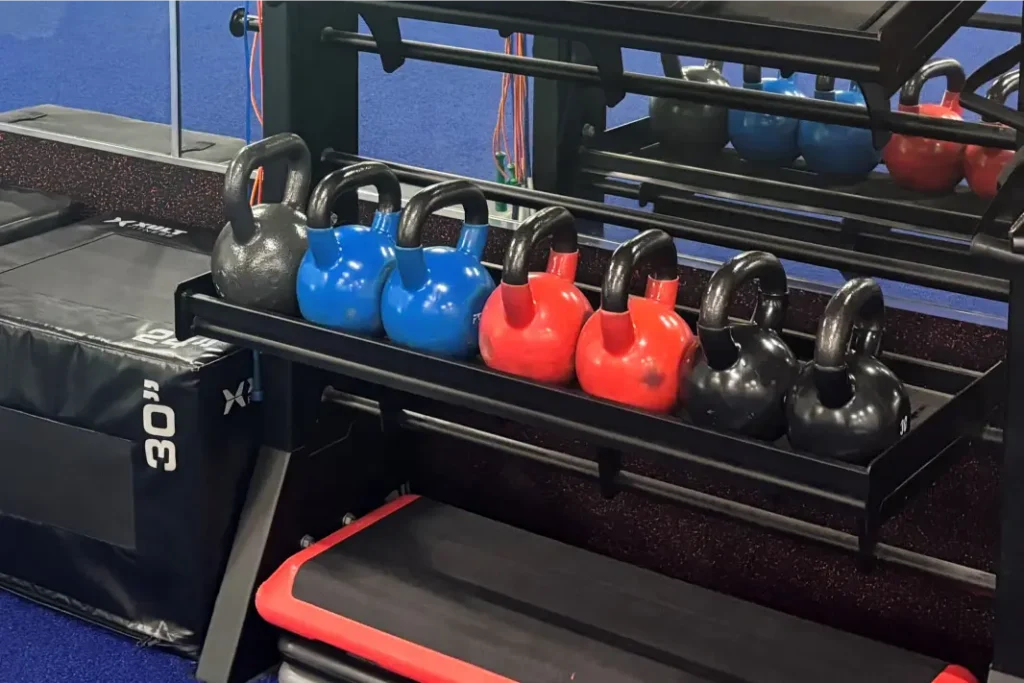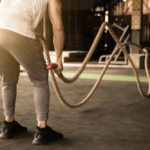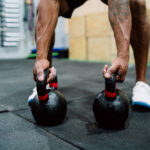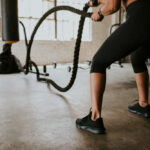Chest day is an essential part of strength training, focusing on building the pectoral muscles along with improving overall upper body strength. Traditionally, workouts involve barbells and dumbbells, but incorporating kettlebells can enhance these routines significantly.
Kettlebells provide a unique challenge due to their shape and weight distribution, which helps in engaging multiple muscle groups simultaneously, including the core and stabilizer muscles. This integration not only diversifies the training regimen but also increases muscular endurance and strength, making each session more dynamic and effective.
Top chest exercises with kettlebells
Here are our favorite exercises that you can try:
Kettlebell bench press
The kettlebell bench press is an excellent exercise for targeting the pectoral muscles. To perform this exercise, lie on a bench and start with a kettlebell in each hand at chest level. Press the kettlebells up and away from the chest until your arms are extended. Lower them back after a short pause. This exercise not only works the chest but also engages the core and improves shoulder stability.
Kettlebell chest fly
Kettlebell chest flys add a new dimension to chest isolation work. Lie on a bench with a kettlebell in each hand, arms extended above the chest. With a slight bend in your elbows, lower your arms to the sides in a wide arc until you feel a stretch in your chest. Bring them back up in the same controlled motion. This exercise focuses on the pectoral muscles but also involves the deltoids and biceps.
Kettlebell push-up variations
Incorporating kettlebells into push-ups can increase their intensity and effectiveness. Place a kettlebell under each hand and perform push-ups as usual. The elevated position increases the range of motion, intensifying the workout. For added challenge, use a single kettlebell and alternate hands with each rep, enhancing balance and core engagement.
How to combine these kettlebells chest exercises
- Circuit training: Creating a circuit that mixes kettlebell exercises with traditional chest exercises can maximize endurance and strength gains. For example, a circuit might include kettlebell bench presses, push-ups, and kettlebell chest flys, performed back-to-back with minimal rest between exercises. This type of training keeps the heart rate up and burns more calories while still focusing on muscle growth.
- Supersets: Supersets involve performing two exercises consecutively without rest and are effective for increasing muscle size and strength. Pair a kettlebell exercise like the kettlebell bench press with a traditional exercise like the dumbbell fly. This approach not only saves time but also intensifies the workout, pushing the muscles to adapt and grow stronger.
Advanced variations to challenge yourself
- Progressive overload with kettlebells: Progressive overload is fundamental to gaining muscle strength and size. With kettlebells, you can apply this principle by gradually increasing the weight of the kettlebell or altering the complexity of the exercises. For instance, once the basic kettlebell bench press becomes less challenging, you might switch to a heavier kettlebell or incorporate a single-arm press to increase the difficulty and stimulate further muscle growth.
- Hybrid exercises: Hybrid exercises combine movements from different exercises to challenge the body in new ways. A powerful hybrid for chest day could be the kettlebell push-up with a row. Perform a push-up with your hands on the kettlebells, then complete a row with one arm while stabilizing your body with the other. This exercise not only targets the chest but also engages the back, shoulders, and core, providing a full upper body workout.
- Incorporating plyometrics: Plyometric exercises involve explosive movements to improve power and speed. Incorporating plyometric techniques with kettlebells can greatly enhance the intensity of your chest workouts. For example, performing a kettlebell throw press involves pressing the kettlebell upwards with force and letting it go briefly at the top of the movement before catching it safely. This requires careful technique and should only be attempted by those comfortable with basic kettlebell maneuvers.
Final thoughts
As with any fitness regimen, the key to success with kettlebells is consistency, proper form, and gradual progression. Always prioritize safety, especially when trying new exercises or increasing the intensity of your workouts. By incorporating the techniques and exercises discussed, you can build a stronger, more resilient upper body equipped for any physical challenge.





